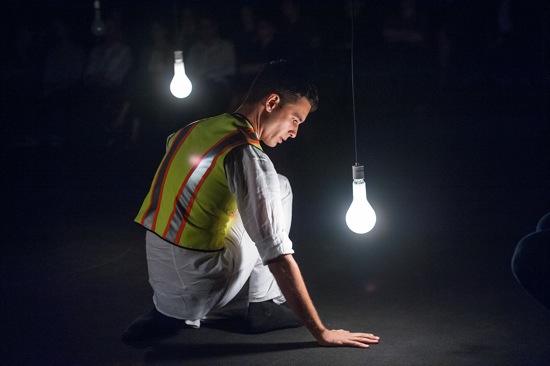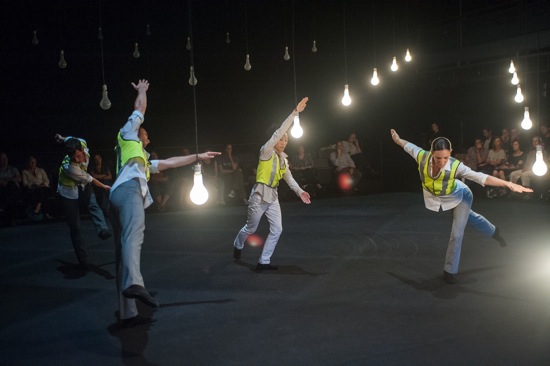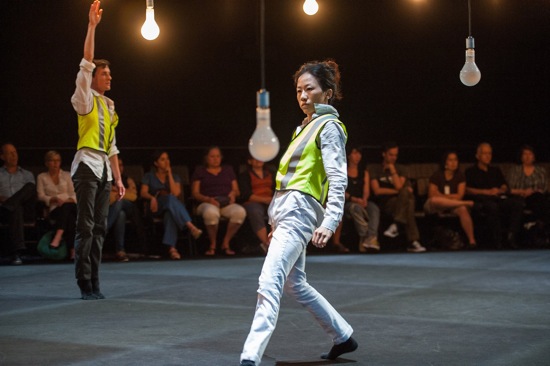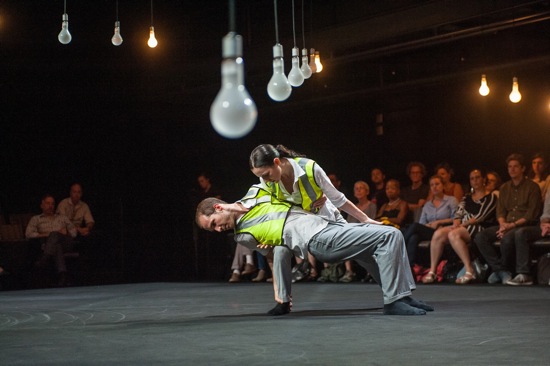i
Eons ago, a solar eclipse made people fall to their knees or consider sacrificing some handy victim. Even when you know astronomy, a rare solar eclipse can feel ominous and a lunar one eerie, but the cosmos is full of smaller eclipses most of us don’t see. A distant planet’s orbiting moons can cast their shadows on one another or on their host.
It’s that slow cosmic game of dodge ball that I thought of while watching Jonah Bokaer and Anthony McCall’s intriguing Eclipse in the Brooklyn Academy of Music’s fine new Richard B. Fisher Building. The commodious Fishman Space is as dark as a night sky or a movie theater, and to accommodate McCall’s light installation and the perspectives the two artists wished to create, the 250 seats are set around four sides of the room and on the balconies above. What we see is an enigmatically shifting interplay among lights, shadows, and moving figures that obscures and reveals and alters them.
Eclipse mates sophisticated technology with simple—even humble—means. David Grubbs’s sound design underlays the performance with the sound of a 16-millimeter projector playing a film we never see (or perhaps the flickering film we do see, created by living performers and lights). At one point, a train’s roar and clatter seems, from where I’m sitting, to approach from far left and travel overhead to near right. Later it makes a return trip. In between these two passages, a plane takes off.
McCall’s installation consists of rows of ordinary-looking 150-watt bulbs, each hanging by its own cord from a grid far above. I don’t fully understand the principle of parallax as it’s used to measure distances to celestial objects, but I know that it deals with the fact that objects in space vary depending on the angle from which they’re viewed. Spectators sitting along one wall of the Fishman may see the rows ascending from the single light closest to them, and a foot above the floor, to ones perhaps 12 feet above the floor at the far end of the room—the whole design fanning out to a row of six and narrowing again. Spectators seated at the high end will see a downward inclination. Those of of us along the other two walls see the slant in profile and can gaze along diagonals or straight across to the wall opposite.
It is in this orderly obstacle course that the five dancers move—striding along its perimeters within touching distance of the first rows of spectators, cutting paths through it, ducking and twisting around low hanging lamps. Various of those lights brighten and fade according to the score laid out by McCall. A whole row may flare into life or, say, three scattered single lamps. The rules governing this continual process of change are mysterious.
At various times, Aaron Copp’s lighting design creates a dim grid on the gray carpeted floor and a framing square of light at its midpoint. Near the end of Eclipse—by lighting the corners of the floor to form triangles—he appears to turn the whole performing area 45 degrees.
In his opening solo, Bokaer visits the hanging lamps with the purposeful curiosity of a celestial anthropologist, although he’s wearing a kind of high-end crossing guard’s vest (designed by McCall) over his white shirt and trousers. Black socks protect his feet. Kneeling by the single lowest bulb, he examines the circle of light it casts. When he nears a lamp level with his face, he stares into it at close range. He bends his head to let another warm the back of his neck. A lower one shows him the lines on his offered palm.
The choreography features a lot of arm gestures, and he directs some of these to lights too high to reach. Sometimes he’s a magician; they come on for him. At other times, they don’t respond, but he remains unperturbed. His pace and daring increase as Adam H. Weinert, CC Chang, Sara Procopio, and Tal Adler-Arieli enter one by one. They wander slowly, their eyes fixed straight ahead, while he veers away from lights, spirals to duck under them, somersaults, slides to the floor, and races to launch himself into a leap.
The first train passage ushers in a new section. Bokaer has left, and, although the other four echo many of his gestures, the atmosphere has changed subtly. Each of the dancers is intent on his or her own agenda, but, as if by telepathy, they may all retreat to the corners, cluster, or fall into unison with big deliberate moves. Initially Adler-Arieli seems to be energized by the lights he examines, and the vigor of his supple dodging around and slipping under ignites the atmosphere. The others become more aware of the space, pausing now and then to gaze intently at us and beyond us.
We are part of the scene. At times, light falls on the bank of spectators opposite me, while my side is in shadow—as if we’re revealed and eclipsed in turn by the passages of the dancers. I become aware too of the moving shadows the four cast on the floor.
Although the performers never touch or disturb the lights, they occasionally come near to colliding with one another, and Bokaer turns his attention to the pull of gravity and magnetic attraction. The two men perform a slow, grave duet in a square of light at the center of the space. The point seems to be that they must keep forming new connections while balancing on only one foot or one knee. Because they treat these imaginative, complicated intersections with the care and concentration of explorers, the maneuvers acquire a reticent warmth that’s strangely moving. At one point, Weinert, tilted over, is bracing himself with a hand on Adler-Arieli’s shoulder, and the latter turns his head to stare down at that hand. It’s a startling moment and a resonant one.
Procopio, who has been moving slowly on the periphery is gradually drawn into the men’s orbit, and for a few minutes, before the “plane” takes off to end this section, the three briefly slip into complex sculptural tangles that make me think of those struggling-warriors monuments.
Adler-Arieli and Procopio are attracted to each other in a more charged way, staring across a short distance and slanting forward until they fall together, braced over the void between their feet. They pause, separate, start over. Once she dives into something vaguely resembling an arabesque penchée, and he catches her. Beyond them, Chang leans slowly back against Weinert and sinks down the length of his body.
I’m intrigued by this little world as it moves between purposefulness and responses to unseen forces, between serenity and impulsiveness. There’s a point at which Eclipse seems to end in darkness, and I’m satisfied with that. But there’s more. Bokaer gets the dancers lying face down. Each rises in turn to perform a very brief solo; when the soloist lies down again, the others shift to align their bodies in a new direction. He’s making a cosmological point, I think, and/or another point about perspective, but I’m more than ready for the solo coda that he fades in.
Now, although he reprises his earlier encounters with the lights, he also falls back from some of the bulbs he approaches. Instead of brightening when he nears them, they dim. The unseen film runs out, and we hear it flap against the still-turning reel, as Bokaer spins into darkness.
The theater that Eclipse inaugurated and the building that houses it are welcome newcomers to Greater New York. BAM Fisher also has offices, a classroom, a studio/performance space, and a roof garden. In the interests of bringing newcomers and those without full pockets to dance, BAM has set ticket prices at $20. May nothing cast a shadow on that!





Lovely writing, an intriguing piece, wish of course I’d seen it for myself, though seeing it through Deborah’s eyes doubles the pleasure.